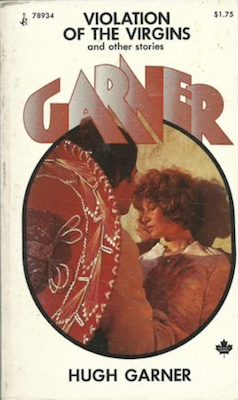 |
| The Calgary Herald, 9 December 1960 |
Halloween - The Mad House
5 hours ago
A JOURNEY THROUGH CANADA'S FORGOTTEN, NEGLECTED AND SUPPRESSED WRITING
 |
| (cliquez pour agrandir) |
Kevin decided that he didn't understand at all; nothing fitted. For one thing, he ought to be feeling a considerable resentment towards her because of the fact that she was deliberately obstructing him – yet all he could feel was admiration for her loyalty. Yet she had lied about Craddock, and if his vague suspicions about Craddock were right, that tied her up directly with what was going on – which was a vastly different thing to her being an unwilling party. He was thinking in circles, he suddenly realized – and gave it up. He must get a lot more facts first.Kevin's method is to visit and revisit his suspects with faith that it will all lead to something. I was reminded more of a Jehovah's Witness than a detective. High Tide is at Midnight is a novella made novel through excessive detail, most of which involves getting the protagonist from visit A to visit B:
At eight o'clock the next morning – a Saturday – Kevin was bowling along over Catford Heath, headed south-east. It was more like April than October – the sky was blue, and there was a golden haze in the crisp air. By eight-twenty-five he was in Farmingham, and he pulled up briefly at a café to drink some steaming hot coffee and eat some buttered toast.Although Kevin is helped along by the odd "odd coincidence" and has the good fortune to stumble, both literarily and figuratively, upon a good many clues, he proves himself incapable of exposing the smugglers. One of his greatest breaks occurs when, quite by chance, he stops in a village in which every single inhabitant is involved with the ring (vicar included). Even this leads to nothing. Shame Craddock is dead; bet he could've figured things out.
Then he went on down the arterial road until he came to the Sevenoaks-Maidstone Road, where he turned left. In Maidstone he stopped to consult his road-map, then pressed on down the Hastings Road for a mile, turned off south-east again on the Class 2 road, finally coming out in Tenterden. There he asked the way from a passing farmhand, and some five minutes later he coasted down into a hollow, and tucked under the hill on the left, close to a brook, there it was – a cottage with a small board attached to a gate on which was written 'THE DELL'.
"You know," he said, "I little thought when I was sitting in the cinema watching your last film a few days ago that I would be soon having you all to myself in a country cottage. I admire your acting enormously."
She said: "Thank you, sir. But seriously – I'm glad. Oddly enough, I want you to… have a good opinion of me."
"Why?"
She shrugged her slim shoulders.
I don't really know – after all, we're practically strangers. But I suppose that it's because intuitively I respect your judgement. Does that sound ridiculous?"
"No," Kevin said, smiling. "And it does my ego a lot of good." He looked over the rim of his cup. "While the Mutual admiration Society is in session, I should like to mention something else. I think that you're the most beautiful woman I have ever seen – and I mean that very sincerely. I hope you don't mind my saying that; anyway, it's said."
 |
| Lobby Girl Gerald Foster Toronto: News Stand Library |
 |
| Never See the Sun Hall Bennett 1950 |
 |
| Carnival of Love Anthony Scott 1950 |
 |
| Strange Desires Alan Malston 1950 |
 |
| Too Many Women Gerry Martin 1950 |
 |
| Hospital Nurse Lucy Agnes Hancock |
It is a novel so scarce that it cannot be found in Canada's largest public library, it's largest university library or even the National Library's copyright deposit.Odd thing about Garner: his books were graced with some of the most disturbing images. He was, of course, a Governor General's Award-winner, once considered one of our greatest short story writers, but you'd never know it to look at these.
 |
| Hugh Garner's Best Stories Richmond Hill, ON: Pocket Books, 1971 |
 |
| A Nice PLace to Visit Toronto: Ryerson, 1970 |
 |
| A Nice Place to Visit Richmond Hill, ON: Pocket Books, 1971 |
 |
| Violation of the Virgins Toronto: McGraw-Hill Ryerson, 1970 |
 |
| Violation of the Virgins Richmond Hill, ON: Pocket, 1975 |
Perhaps it's all the hype and determined salesmanship of McClelland and Stewart. Perhaps, more likely, it's that Rohmer neatly touches Canadian themes in a country starving for Canadian themes. Perhaps the very superficiality engages interest without emotion, so that there's no investment of the mind and spirit, and the reading is easy. Or perhaps we're just a not very discriminating public…Perhaps it's all four, but I think the second is key. My pre-teen self was starved for Canadian fiction, and the wire racks of Kane's Super Drug Mart in Kirkland, Quebec, provided what the Lakeshore School Board did not. Rohmer's talent lay in an uncanny ability to tap into his fellow citizens' fantasies and fears. Separation, about the threatened succession of Quebec, was published the month before the surprise victory of the Parti Québécois in the 1976 provincial election.

